Blog
How to outsource your nonprofit’s human resources function
Outsourcing human resources can give your not-for-profit’s staff more time to spend on core duties and mission-driven programs and it may be cost-effective. Here are some suggestions if you’re thinking about outsourcing part or all of your HR tasks. First steps First, decide which segments of the HR function to farm out. Take a look at payroll, recruiting, training, benefits planning and administration, compliance monitoring, leave management and performance reviews. These are all labor-intensive responsibilities where expertise counts. Transferring all or some of them to the right outside party can vault your organization to a higher level of professionalism
Did I Miss a Tax Credit?
Now that "Tax-Time" is unofficially ended for most people many people should be taking time to ask, "Did I miss anything". For the tax professional, "Tax-Time" never ends. It is an ongoing year of planning and review to make sure your clients are in the best position they can be from a tax standpoint. With the passing of the tax overhaul, many professionals are finding this time is more important than the season itself. Without good communication between you and your CPA many things that a business owner does not see as important can be tax windfalls. Most people think
Will leasing equipment or buying it be more tax efficient for your business?
Recent changes to federal tax law and accounting rules could affect whether you decide to lease or buy equipment or other fixed assets. Although there’s no universal “right” choice, many businesses that formerly leased assets are now deciding to buy them. Pros and cons of leasing From a cash flow perspective, leasing can be more attractive than buying. And leasing does provide some tax benefits: Lease payments generally are tax deductible as “ordinary and necessary” business expenses. (Annual deduction limits may apply.) Leasing used to be advantageous from a financial reporting standpoint. But new accounting rules that bring leases to
Audits home in on cybersecurity
In 2018, U.S. organizations that suffered a data breach lost an average of $7.91 million as a result. That’s the highest average organizational cost of all the countries and regions covered in the 2018 Cost of a Data Breach Study by IBM and independent research firm Ponemon Institute. Malicious or criminal attacks were the source of more than half of those breaches, rather than system glitches and human errors. With so much at stake, it’s no surprise that auditors consider these issues when conducting their audit risk assessments. This audit season, prepare to answer questions about cybersecurity and the effectiveness
Are your employees ignoring their 401(k)s?
For many businesses, offering employees a 401(k) plan is no longer an option — it’s a competitive necessity. But employees often grow so accustomed to having a 401(k) that they don’t pay much attention to it. It’s in your best interest as a business owner to buck this trend. Keeping your employees engaged with their 401(k)s will increase the likelihood that they’ll appreciate this benefit and get the most from it. In turn, they’ll value you more as an employer, which can pay dividends in productivity and retention. Promote positive awareness Throughout the year, remind employees that a 401(k) remains
Private companies: Have you implemented the new revenue recognition standard?
Private companies that follow U.S. Generally Accepted Accounting Principles (GAAP) must comply with the landmark new revenue recognition standard in 2019. Many private company CFOs and controllers report that they still have significant work to do to meet the demands of the sweeping rules. If you haven’t started the implementation process, it’s time to get the ball rolling. Lessons from public company peers Affected private companies must start following Accounting Standards Update (ASU) No. 2014-09, Revenue from Contracts with Customers (Accounting Standards Codification Topic 606), the first time they issue financial statements in 2019. For private companies with a fiscal
Protect retirement plan fiduciaries through training and insurance
When an employer decides to sponsor a retirement plan for employees, it takes on great responsibility. Anyone who exercises discretionary authority over any vital facet of plan operations likely will be considered a plan fiduciary. In turn, these individuals face a significant risk of liability if anything goes seriously wrong with the plan. Your plan document should identify the corporate entity or individual serving as the “named fiduciary.” But other common examples of fiduciaries include those who serve as plan trustees and members of the board of directors. It’s critical to protect these individuals from the potential negative outcomes of
5 questions can help nonprofits avoid accounting and tax mistakes
To err is human, but some errors are more consequential — and harder to fix — than others. Most not-for-profit organizations can’t afford to lose precious financial resources, so you need to do whatever possible to minimize accounting and tax mistakes. Get started by considering the following five questions: Have we formally documented our accounting processes? All aspects of managing your nonprofit’s money should be reflected in a detailed, written accounting manual. This should include how to accept and deposit donations and pay bills. How much do we rely on our accounting software? These days, accounting software is essential to
How do profits and cash flow differ?
Business owners sometimes mistakenly equate profits with cash flow. Here’s how this can lead to surprises when managing day-to-day operations — and why many profitable companies experience cash shortages. Working capital Profits are closely related to taxable income. Reported at the bottom of your company’s income statement, they’re essentially the result of revenue less the cost of goods sold and other operating expenses incurred in the accounting period. Generally Accepted Accounting Principles (GAAP) require companies to “match” costs and expenses to the period in which revenue is recognized. Under accrual-basis accounting, it doesn’t necessarily matter when you receive payments from
Here Comes 2019!
New Limits and Rates for 2019 As we burn the midnight oil to complete all of our last minute year-end tax planning, we also look forward to 2019. Each year many of the "standard" limits and rates provided as a part of our tax code are updated for inflation and other normal increases. To help in your 2019 organizing, please remember to take into account some of these new rates and limits: Tax Provision Details 2019 Limit 2018 Limit Mileage Rates Standard Business Mileage Rate 58 cents 54.5 cents Charitable Mileage Rate 14 cents 14 cents Medical Mileage


